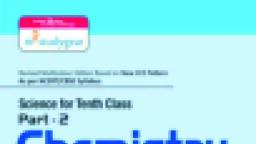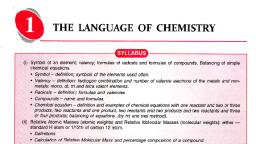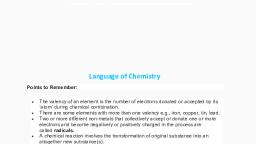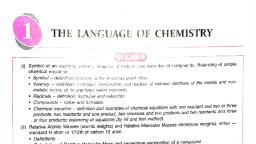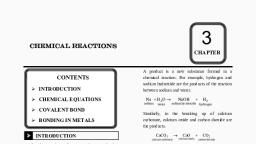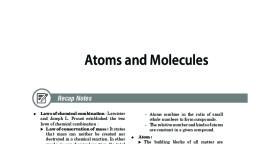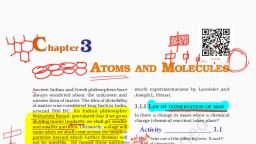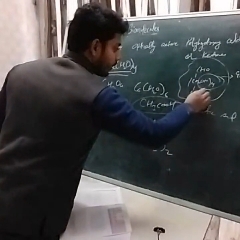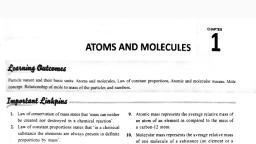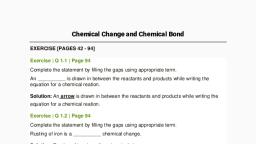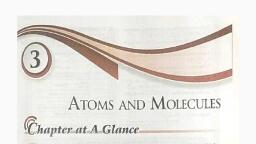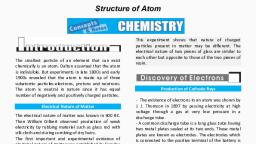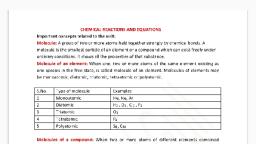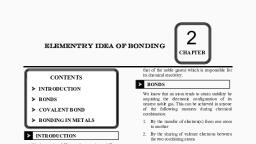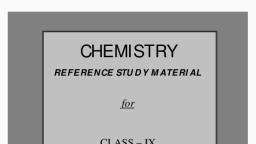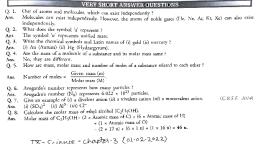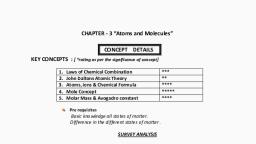Page 2 :
Q. What do you mean by Symbol ?, A. A symbol is a short form of an element. A symbol represents a specific element or one atom of an element. A, symbol also represents the weight of the element equal to its atomic weight., Q. Give the qualitative meaning of the symbol., A. A symbol represents a specific element or one atom of an element. It is the qualitative meaning of the term, ‘symbol’., Q. Give the quantitative meaning of the symbol., A. A symbol also represents the weight of the element equal to its atomic weight. It is the quantitative meaning of, the term ‘symbol’., Q. Name three metals whose symbols are derived from - a) the first letter of the name of the element, b), their latin name ?, A. Three metals whose symbols are derived from the first letter of the name of the element → Carbon (C) , Sulphur, (S), Boron (B)., Three metals whose symbols are derived from their latin name → Copper (Cu), Iron (Fe), Silver (Ag), Q. What do you mean by Valency ?, A. Valency is the number of hydrogen atoms which can combine with (or displace) one atom of the element (or, radical) forming a compound. Also it can be defined as the number of electrons an atom can donate or accept so as, to achieve a stable electronic configuration of the nearest noble gas., Q. Reason for showing variable valency ?, A. An atom of an element can sometimes lose more electrons than are present in its valence shell, i.e., lose from the, penultimate shell (last but one) and hence exhibit more than one or variable valency. E.g., Cuprous and Cupric., Q. What do you mean by radicals ?, A. A radical is a group of atoms of elements that behaves like a single unit and shows a valency., Q. What do you mean by acid radicals ?, A. Negatively charged radicals are called acid radicals., Q. What do you mean by basic radicals ?, A. Positively charged radicals are called basic radicals., , Page | 2
Page 3 :
Q. What do you mean by chemical formula ?, A. A molecule of a substance, i.e., element or compound could be represented by symbols. This representation is, known as chemical formula., Q. What do you mean by a Compound ?, A. A compound is a pure substance, composed of two or more elements combined chemically in a fixed proportion, but the properties of the compound are completely different from those of its constituent elements., Q. What are the characteristics of a Compound ?, A. The characteristics of a compound are as follows →, 1. Components present in a definite proportion., 2. Compound is always homogeneous., 3. Particles in a compound are of one kind., 4. Compound has a definite set of properties., 5. Components in a compound do not retain their original properties and can be separated only by chemical, means., Q. What do you mean by a chemical equation ?, A. A chemical equation is a shorthand form for a chemical change. The chemical equation shows the result of a, chemical change in which the reactants and the products are represented by symbols (in case of elements) and, elements (in case of compounds)., Q. What do you mean by the reactants ?, A. The substances which take part in a chemical reaction are called reactants., Q. What do you mean by the products ?, A. The substances formed as a result of chemical change are called product., Q. What is a balanced equation ?, A. The balanced equation is one in which the number of atoms of each element is the same on the side of the, reactants and on the side of the products., Q. Why should an equation be balanced ?, A. All equations must be balanced in order to comply with the “Law of Conservation of Matter”, which explains, that matter is neither created nor destroyed in the course of a chemical reaction. An unbalanced equation would, imply that atoms have been created or destroyed., , Page | 3
Page 4 :
Q. What do you mean by the relative atomic mass ?, A. Relative atomic mass of an element is the number of times one atom of an element is heavier than, , 1, 12, , the mass, , 12, , of an atom of carbon [C ]., Q. What do you mean by gram atomic mass or gram atom ?, A. The relative atomic mass of an element expressed in grams is known as gram atomic mass or gram atom of that, element., Q. What do you mean by the relative molecular mass ?, A. Relative molecular mass of an element / compound is the number of times one molecule of the substance is, 1, heavier than 12 the mass of an atom of carbon [C12]., Q. What do you mean by gram molecular mass or gram molecule ?, A. The relative molecular mass of a substance expressed in grams is known as gram molecular mass or gram, molecule of that element., Q. What do you mean by the atomic mass unit ?, 1, A. Atomic mass unit is defined as 12 the mass of an atom of carbon [C12]., Q. What do you mean by atomic weight ?, A. The atomic weight is the weighted average of the atomic weight of its natural isotopes., Q. XCl2 is the chloride of a metal X. State the formula of the sulphate and the hydroxide of the metal X., A., , Page | 4
Page 5 :
Q. An element X is trivalent. Write the balanced equation for the combustion of X in oxygen., A. Combustion of X3+ in oxygen means oxide of X →, , Q. The formula of the nitride of a metal X is XN, state the formula of :, 1. its sulphate, 2. its hydroxide., A. Formula of nitride of metal X is XN, Since valency of nitrogen is 3∴ Valency of X is 3+, , Q. What is the valency of nitrogen in :, 1. NO, 2. N2O, 3. NO2, A., , Page | 5
Page 6 :
Q. Give examples of eight metals which shows variable valency. State the valency of sulphur in :, (a) SO2, (b) SO3, A., , Therefore the Valency of sulphur is 6., , Page | 6
Page 7 :
Q. State the variable valencies of the following elements and give their names., (a) Cu, (b) Ag, (c) Hg, (d) Fe, (e) Pb, (f) Sn, (g) Mn, (h) Pt, (i) Au, A., , Q. State which of the following elements or radicals are divalent –, (a) Lithium, (b) Nickel, (c) Ammonium, (d) Bromide, (e) Sulphite, (f) Nitride, (g) Carbide, (h) Chromium,, (i) Bisulphite, (j) Dichromate, (k) Permanganate., A., (b) Nickel, (e) Sulphite, (j) Dichromate are divalent, Q. Name the elements in the compound and give the formula – of the following compounds :, (a) Nitric acid, (b) Carbonic acid, (c) Phosphoric acid, (d) Acetic acid, (e) Blue vitriol, (f) Green vitriol, (g), Glauber’s salt, (h) Ethane, (i) Ethanol, A., , Page | 7
Page 8 :
Q. State why the chemical formula of Zinc Carbonate is ZnCO3 ., A. Valency of Zn is 2+ and the valency of CO3 is 2-. In this case the valency of both the atom and radical is the, same. Now the HCF of the valency numbers of the above two atom and radical is 2. So by dividing the valency, numbers by the HCF we will get the simple ration of number of atom or radical is 1: 1. So the molecular formula, will be (Zn)1(CO3)1. Therefore the simplified molecular formula of Zinc Carbonate is ZnCO3 ., Q. Write the names of the following compounds :, , A., , Page | 8
Page 9 :
Q. Give an example of a chemical equation in which, (a) one product (b) two products (c) three products (d) four products., A., , two, , reactants, , Q., (a) State what is a ‘balanced equation’. (b) Give a reason why the above equation is balanced., (c) State why the compound MnO2 is written above the arrow., , Page | 9, , form, , –
Page 10 :
A., (a) Balanced equation : Equation in which the total number of atoms of each element in the reactants, on the left, side of the equation is equal to the number of atoms of each element in the products formed, on the right side of the, equation., (b) As the total number of [K, Cl, O] atoms on the L.H.S. is equal to the number of the given atoms on the R.H.S.,, the given equation is balanced., (c) MnO2 is a catalyst in the reaction which does not undergo any change and simply increases the rate of reaction, is written above the arrow., Q., (a) State the information provided by the above chemical equation., (b) State the information not conveyed by the above chemical equation., A. (a) Information provided by equation :, 1. Calcium carbonate reacts with [dil.] hydrochloric acid to produce calcium chloride, water and Carbondioxide., 2. One molecule of calcium carbonate reacts with two molecules of acid to produce one molecule of calcium, chloride, one molecule of water and one molecule of carbondioxide., 3. About the chemical composition of respective molecules like one molecule of calcium chloride contains one, atom of calcium, one atom of carbon and three atoms of oxygen., 4. Molecular masses, , that 100 parts by weight of calcium carbonate reacts with 73 parts by weight of hydrochloric acid to produce, 111 parts by weight of calcium chloride 18 parts by weight of water and 44 parts by weight of carbon dioxide., 5. That reaction is irreversible., 6. That about the state of substances present i.e. solid, liquid or gas., (b) Information not conveyed are :, 1. Time, reaction takes to complete., 2. About the concentrations of reactants and products., 3. Speed of reaction., 4. Changes in colour occuring – during the reaction., 5. Whether heat is given out or absorbed during the reaction., 6. The physical state of reactants and products., , Page | 10
Page 11 :
Q. Write balanced equations for the following word equations :, 1. Potassium nitrate → Potassium nitrite + Oxygen, 2. Calcium + Water → Calcium hydroxide + Hydrogen, 3. Iron + Hydrochloric acid → Iron [II] chloride + Hydrogen, 4. Nitrogen dioxide + Water + Oxygen → Nitric acid, 5. Lead dioxide [lead (IV) oxide] → Lead monoxide + Oxygen, 6. Aluminium + Oxygen → Aluminium oxide, 7. Iron + Chlorine → Iron [III] chloride, 8. Potassium bromide + Chlorine → Potassium chloride + Bromine, 9. Potassium bicarbonate → Potassium carbonate + Water + Carbon dioxide, 10. Calcium hydroxide + Ammonium chloride → Calcium chloride + Water + Ammonia, A., , Q. Give balanced equations for (1) & (2) by partial equation method, [steps are given below], (1) Reaction of excess ammonia with chlorine – Ammonia as a reducing agent, (a) Ammonia first reacts with chlorine to give hydrogen chloride and nitrogen., (b) Hydrogen chloride then further reacts with excess ammonia to give ammonium chloride., (2) Oxidation of Lead [II] Sulphide by Ozone, (a) Ozone first decomposes to give molecular oxygen & nascent oxygen., (b) Nascent oxygen then oxidises lead [II] sulphide to lead [II] sulphate., A. (1), (a) Ammonia reacts with chlorine to give hydrogen chloride and nitrogen., (b) Hydrogen chloride reacts with excess ammonia to give ammonium chloride., , Page | 11
Page 12 :
(2), (a) ozone decomposes to O2 (molecular) and nascent oxygen., (b) Nascent oxygen oxidises Pb [II] sulphide to Lead [II] sulphate and needs 4 atoms of oxygen to form, sulphate. Hence 1st equation must be multiplied by 4. Canceling 4 atoms of oxygen from both sides and adding., , Q. 1. Calculate relative molecular mass of, (a) ZnCO3, (b) CaSO4 [Zn = 65, S=32, O = 16, Ca = 40, C = 12], 2. Calculate the percentage composition of, (a) Calcium Chloride, (b) Calcium Nitrate [Ca = 40 , Cl = 35.5 , N = 14 , O = 16], , A., , Page | 12
Page 13 :
Page | 13

